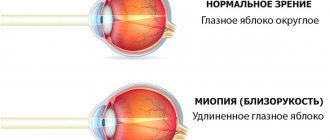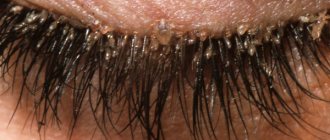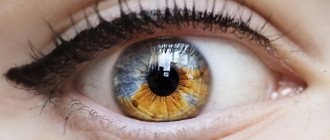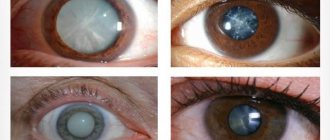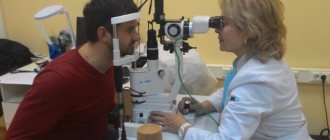A cataract is a clouding of the eye lens. Very often this pathology can be observed in newborns. Severe deterioration of vision occurs due to cataracts, and in most cases it is possible to restore normal functioning of the eye only with the help of surgical intervention. Without the necessary treatment, there is a high probability of even becoming visually disabled.
Share
Tweet
Share
Cool
Send
Definition of disease
Cataract is a clouding of the eye lens that leads to visual deprivation, that is, a deterioration in stimulation of the sensory system. The retinal receptors begin to work worse due to the fact that the cloudy lens does not allow light in the required volumes to reach the cones, which translate irritations from light into nerve impulses.
This disease occurs in approximately one newborn per 10,000. Moreover, the bilateral form of cataracts in children is observed more often than its unilateral counterpart.
It is customary to divide cataracts in children into those associated with hereditary anomalies and non-hereditary ones.
Complications of congenital cataracts
Complications include:
- blindness;
- amblyopia;
- strabismus;
- nystagmus;
- macular degeneration of the retina;
- pathologies of the vitreous body;
- optic nerve atrophy;
- earlier development of refractive errors and accommodation in the fellow eye (due to the increased load on it several times).
Postoperative complications include secondary glaucoma, retinal detachment, swelling of the eye structures, and implant rejection.
Causes of cloudy lens in a child
It is not always possible to determine the cause of cataracts in children. Currently, ophthalmologists identify several main ones:
- Heredity factor. 20% of cases of the disease occur due to the transmission of pathology by the genes of parents to the child.
- Infections during the mother's pregnancy:
- rubella;
- toxoplasmosis;
- cytomegolovirus;
- chicken pox;
- herpevirus.
- At the birth of premature babies.
- Mechanical damage. The disease may appear after an eye injury or surgery.
- Galactosemia, the cause of which is associated with a metabolic failure in the body. This pathology is characterized by disturbances in the production of the enzyme galactose.
- Toxocariasis is a parasitic infection; humans become infected with this disease through animal feces.
Prevention of congenital and acquired cataracts
To reduce the risk of developing congenital cataracts, it is necessary to exclude harmful influences, stress and infections during pregnancy. If there is information about a hereditary predisposition to the disease, the pregnancy is carried out taking this into account, and the vision of the newborn is examined immediately after birth.
To reduce the likelihood of cataracts occurring throughout your life, you need to protect your eyes from prolonged exposure to sunlight, avoid exposure to radiation and intoxication, including direct contact of harmful substances with your eyes. Needless to say, it is necessary to be attentive to any changes in visual acuity, regularly undergo preventive examinations by an ophthalmologist, and also promptly seek medical help for injuries and infectious diseases of the eyes.
Classification
There are different types of cataracts in children, they are distinguished depending on the reasons that led to the development of the disease:
- Congenital cataract . This type is diagnosed either immediately after the birth of the child or after a few weeks of his life. This pathology can be transmitted from parents, and also develop due to metabolic disorders in the newborn.
- Acquired cataract. This type appears for several months and even years after the baby is born. Pathology can appear due to eye injury or after surgery on the visual organ.
- Secondary cataract. Appears when complications occur after cataract surgery. In this case, clouding of the posterior capsule of the lens occurs, and surgical intervention is also required to treat this type of disease.
Due to its wide prevalence, congenital cataracts are classified into a separate classification based on the location of the opacification. There are the following types, which will be discussed below.
Spot
This species is quite rare, and the manifestations of pathology are not so noticeable. Vision, for example, decreases slightly. However, with a further increase in visual load, for example, at school, a child’s vision may deteriorate. This type of cataract develops pointwise and has the following symptoms:
- Cloudiness on the lens spreads in the form of individual dots or scattered areas of a heterogeneous type;
- The color of the protein does not change or becomes slightly lighter than usual;
- The decrease in vision is not severe, most often manifested by blurred images.
The development of this type of cataract is associated with one of the following reasons:
- Pathologies of chromosomes.
- Prematurity.
- Infection of the fetus during pregnancy.
- Systemic diseases of the background type (diabetes mellitus, problems with calcium metabolism, Wilson's disease, autosomal recessive syndrome, hypoglycemia).
Causes of congenital cataracts
The cause of about a quarter of cases of the disease is heredity. The pattern of inheritance is autosomal dominant, autosomal recessive or X-linked gene. The hereditary type of cataract develops in combination with other hereditary pathologies (Marfan, Down, Marchesani syndromes).
There are cataracts that developed as a result of chromosomal aberrations - mutations in certain genes. The protein component of the lens fibers consists of crystallins and connexins. Crystallins are proteins of a crystalline nature, which make up 90% of lens fibers. Connexins are proteins that provide connections between fibers. Mutations in the genes encoding two proteins lead to clouding of the biological lens.
The next group of reasons are hereditary metabolic disorders of calcium and carbohydrate metabolism:
- galactosemia;
- deficiency of galactokinase, glucose-6-phosphate dehydrogenase;
- homocystinuria.
Infections of the mother during pregnancy have a teratogenic effect:
- rubella;
- flu;
- toxoplasmosis;
- infections caused by cytomegalovirus and Epstein-Barr virus;
- chicken pox.
For the convenience of remembering maternal infections as the main sources of lens damage, it is customary to use the acronym TORCH (T - toxoplasmosis, O - others; R - rubella - rubella; C - cytomegalovirus; H - herpes - herpes). It was revealed that the rubella virus in the first trimester is more dangerous as a trigger mechanism. In this case, the newborn develops Gregg's triad - congenital cataracts, deafness and heart disease.
A number of other reasons:
- severe toxicosis;
- use of medications – corticosteroids, contraceptives, thalidomide (a sedative), abortifacients;
- deficiency of vitamins (mainly A and E), folic and pantothenic acid;
- drinking alcohol;
- concomitant maternal pathology - cardiovascular diseases, diabetes mellitus, hypothyroidism;
- Rhesus conflict;
- exposure to radiation.
Clinical manifestations
Cataracts in a newborn child can be detected through periodic medical examinations, so it is necessary to undergo them in a timely manner. You can independently determine this disease in the following cases:
- the child does not respond to toys that do not make sounds;
- the child's vision is unfocused;
- eye movements are fast and uncontrollable;
- the pupil is white or gray.
If these symptoms occur, you should immediately contact a pediatric ophthalmologist. At this age, timely treatment is of great importance for a favorable prognosis of the disease.
In older children, it is easier to identify cataracts, since they are accessible to verbal contact and can themselves assess the quality of their vision. Clinical manifestations are:
- strabismus;
- white pupillary reflex;
- decreased vision in both eyes or just one;
- nystagmus;
- seeing double.
Strabismus develops due to the fact that due to clouding it is impossible to focus the image on the retina with both eyes. In this case, one of the eyes deviates either toward the nose or outward.
REFERENCE. The white pupillary reflex is determined using a slit lamp. This sign is absolute for determining cataracts.
Differences between congenital and acquired diseases
Cataracts in children can be congenital if the disorder occurs during the formation of the fetus, that is, it is an intrauterine pathology. There can be many reasons why a child is born with impaired vision. This can happen when drinking alcohol during pregnancy, with an increased level of dangerous radiation, with a lack of vitamins before and during pregnancy, if a Rh conflict occurs between the child and mother
Etiology
It is not possible to find the exact cause of cataracts, but there are factors that may predispose to its development:
- hereditary factor;
- diabetes;
- intrauterine infections;
- toxic effects;
- injuries;
- metabolic disease;
- parasitic diseases.
The leading factor in the appearance of congenital cataracts is heredity. Often among close relatives of a sick child (mother, father, brothers and sisters) cases of cataracts in the anamnesis are identified.
The disease is linked to certain genes, and there is a high probability of cataracts in the offspring.
Causes of congenital pathology in children:
But congenital cataracts are also registered in children without a family history . How can this be explained?
The fetus is very susceptible to viral infections in the first trimester of pregnancy.
If at this time it is attacked by viruses, then the congenital form may develop and will become the least of the evils that viruses can cause to the fetus.
Pathogens of intrauterine infection:
- cytomegalovirus;
- chickenpox virus;
- herpes;
- rubella virus.
In diabetes mellitus, there is an increase in glucose content in the lens due to hyperglycemia. The fibers of the lens swell and lose their transparency - this is how this type of cataract begins.
With galactosemia, galactose accumulates in the lens in a similar way. In transmitted light it looks like oil drops. These accumulations can be seen already during the first days of a child’s life.
With traumatic lesions, regardless of age, rosette-shaped cataracts occur , which progress and can completely occupy the entire lens.
Cloudiness of the lens can occur as a complication of other diseases. For example, with uveitis, inflammatory products can penetrate into the lens, which leads to the development of cataracts.
Various radiations have a negative effect on the lens: infrared, ultraviolet. Peeling of the anterior chamber of the lens occurs, which leads to its clouding.
When there is a deficiency of calcium ions in the body, calcium cataracts occur. Its development is possible with the removal of the parathyroid glands, which are responsible for calcium metabolism.
Cloudiness appears in the form of small, sometimes bright spots on the pupil, which can be seen with the naked eye. Treatment of children with pinpoint cataracts is long-term.
Chronic use of certain drugs can also lead to illness. The list includes hormonal drugs and cardiac glycosides.
The ingress of various substances, such as alkalis, leads to toxic cataracts. Alkali reduces the acidity of the anterior chamber of the eye, glucose is washed out of the lens.
Diagnostics
Congenital cataracts are usually detected during the first examination of a newborn. However, the pediatrician cannot always determine whether a baby has vision problems. Most often, symptoms of the disease are noticed when you return to a medical facility for a routine examination.
The ophthalmologist first collects anamnesis (information about medical history, previous diseases, etc.). After this, he checks visual acuity, examines the retina, identifies visual fields, and measures the pressure inside the eyeball.
Possible examinations necessary for an accurate diagnosis of the child:
- Ophthalmoscopy – examination of the fundus of the eye with a mirror or electric ophthalmoscope;
- Optical coherence tomography (OCT) - scanning the layers of the retina;
- Biomicroscopy – examination of the cornea, lens, anterior segment of the eye. The procedure is carried out in complete darkness, a light beam is directed onto the lens of the eye and the transparency of the lens, refractive power, etc. are determined through a microscope.
Treatment of congenital cataracts
For mild clouding of the optical lens, intraocular administration of ascorbic acid, vitamins, and cytoprotectors is practiced. Congenital cataracts often require surgical removal of the affected lens.
An artificial lens is implanted in its place. If implantation is contraindicated due to age, it is postponed. Many extraction methods have been developed. The specific method is selected individually, taking into account the patient’s medical history, life, age, concomitant pathology and risk assessment.
Therapy
The sooner a cataract is detected, the higher the chances of successfully getting rid of it. When cataracts are removed in a child before six months of age, the likelihood of proper eye development is greatest. At the same time, the bilateral form is cured better and faster than the unilateral one.
Thanks to the development of modern medicine, the prognosis for the disease is favorable, but depends on the following factors: the severity of the disease, the area affected, as well as concomitant diseases.
Traditional methods
There are many traditional methods for treating cataracts. The most popular of them are the following:
- Drops with honey and apple. Take a small apple and cut off the top of it. After this, the entire core is removed. Place 2 teaspoons of honey into the resulting recess. Then the apple is closed at the top with the cut off top. The fruit is left in this form for 2 days. After this time, the juice from the apple is poured into a container. Then the liquid is instilled into the eyes, one or two drops three times a day. The product is stored in the refrigerator.
- Honey. For a honey compress, take 1 tsp. Add this product to 1 cup of hot water and boil for several minutes. After cooling, a piece of gauze is soaked in the mixture and applied to the eyes as a compress. This procedure is carried out every night, keeping the gauze on the eyes for 5 minutes.
- Onion drops. The onion is peeled, grated and the juice is decanted from the pulp, which is then mixed with water 1 to 1. It is better to take purified or distilled water. The resulting infusion is dropped into the eyes every day.
- Infusion of potato sprouts. Potato sprouts are collected and dried. Dry sprouts (1 tbsp) are poured with vodka (0.5 liters). The resulting mixture is infused for a week in a cool, dark place. The infusion is used one teaspoon three times a day.
Drug treatment
Drug treatment has the following goal: increasing blood circulation; improvement of metabolic processes that affect the transparency of the lens; saturating the eyes with vitamins and other missing substances.
Symptoms and phases
Translated from Greek, kataraktes means waterfall, which in itself explains the main symptom of the disease - blurred vision. The patient sees as if through a veil or foggy glass, the contours of objects are blurry and indistinct. As cataracts develop, the pupil of the eye becomes cloudy and becomes white, gray, or yellowish. In addition, the presence of cataracts can be determined by the following symptoms:
- It is difficult to sew, read, and perform activities that require focusing vision.
- Flashing spots or streaks before the eyes.
- Double vision, especially when the other eye is closed (this is an early symptom that disappears as the disease progresses).
- The appearance of halos around objects in the sun.
- Sensitivity to bright light and photophobia.
- The appearance of flashes and glare, mainly at night.
- Difficulty distinguishing colors (especially blue and purple shades).
There are several phases of cataracts: initial, immature, mature and overripe. During the initial stage, a slight decrease in vision is observed; in the immature stage, vision deterioration is more than 10%. If a person has mature cataracts, then he can only see light. In the overripe form of the disease, spontaneous resorption of the lens occurs, which entails a high risk of complications.
How cataracts affect vision
The lens is a biconvex optical lens, which should be completely transparent at birth. Its main role is to focus the image on the retina. To make it clear and bright, the lens constantly changes its optical power.
Normally, a child does not even have a blood supply to the lens. It receives nutrition from the liquid substance inside the visual organ. A combination of certain external and internal factors leads to disturbances in the composition of protein fiber. They, in turn, lead to a loss of lens transparency and the formation of spots of different locations, shapes and sizes. This disrupts the perception of surrounding objects, reducing the ability to clearly see their contours and details.
Congenital cataracts, which are diagnosed in adults, are a direct consequence of lens opacity in newborns. It may not bother the patient for many years. The entire visual system develops before the age of seven. If the lens becomes cloudy at this time, surgical intervention in the future is inevitable.
The visual organs are connected to the brain, they perceive objects and send signals to certain parts of it. If a child has a cataract in one eye before the age of 7, this results in a blurry picture. The brain gradually learns to ignore this signal; it focuses on high-quality, detailed images coming from a healthy visual organ. This feature carries a risk of developing amblyopia, which in medicine is called lazy eye syndrome.
If the lens becomes cloudy in both eyes at the same time, the brain receives two identical and unclear images. This limits the development of the visual system, which in adults leads to serious problems with the health of this organ. Doctors recommend that young parents do not refuse to undergo diagnostics at the slightest suspicion.
Recovery after cataracts in children
After cataract removal, the baby requires optical correction, which will ensure that light rays are correctly focused on the retina. For these purposes, glasses or contact lenses are prescribed, or an artificial lens is implanted into the eye.
Glasses are a safe way to correct vision in children who have had cataract treatment. This method is recommended for patients whose clouding affects both eyes. Glasses usually have strong but thick lenses and are prescribed on an ongoing basis.
The natural lens has a transparent and flexible structure, providing clear and clear vision of objects at different distances. Since cataract therapy involves removing the lens, after treatment the child loses the ability to focus. Multifocal and bifocal glasses can restore vision. Multifocals provide near, far and intermediate vision. Bifocal lenses allow you to see clearly near and far.
Children who have cataracts in only one eye cannot use glasses. They are prescribed implantation of an artificial lens or wearing contact lenses. Typically, rigid, breathable lenses of high optical power are prescribed that do not cause discomfort.
Several visits to the doctor are required to select the correct lens parameters. The ophthalmologist should inform parents about the rules for wearing lenses and caring for them. Since lenses need to be worn every day, parents should teach their child how to remove and put them on. Proper care of contact lenses and adherence to wearing regimen are a guarantee of comfortable vision.
As your child grows, contact lenses will need to be replaced. It is noteworthy that at an early age, optical systems need to be changed frequently. If opacities are detected at an early stage and treated adequately, it is possible to rid a child of cataracts and prevent complications in the vast majority of cases.


